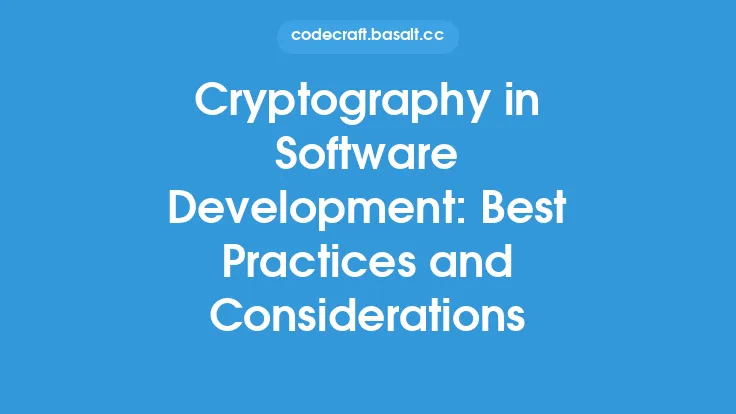Creating effective threat models is a crucial aspect of cybersecurity, as it enables organizations to identify, assess, and mitigate potential threats to their assets. A well-crafted threat model helps to ensure that security controls are proportionate to the risks faced by an organization, and that resources are allocated efficiently to protect against the most significant threats. In this article, we will explore the best practices and common pitfalls associated with creating effective threat models.
Introduction to Threat Modeling
Threat modeling is a systematic approach to identifying, analyzing, and mitigating threats to an organization's assets. It involves a thorough understanding of the organization's assets, vulnerabilities, and potential threats, as well as the likelihood and potential impact of a successful attack. Threat modeling is an essential component of a robust cybersecurity strategy, as it enables organizations to prioritize their security efforts and allocate resources effectively.
Best Practices for Creating Effective Threat Models
To create effective threat models, organizations should follow several best practices. First, it is essential to identify and prioritize the organization's assets, including data, systems, and infrastructure. This involves categorizing assets based on their sensitivity, criticality, and business value. Next, organizations should conduct a thorough threat analysis, which involves identifying potential threats, assessing their likelihood and potential impact, and prioritizing them based on their risk score. Organizations should also consider the attack vectors and vulnerabilities that could be exploited by attackers, as well as the security controls and mitigations that are in place to prevent or detect attacks.
Another best practice is to use a structured threat modeling methodology, such as STRIDE, PASTA, or OCTAVE. These methodologies provide a framework for identifying and analyzing threats, and can help to ensure that threat models are comprehensive and consistent. Additionally, organizations should involve a cross-functional team in the threat modeling process, including representatives from security, development, operations, and business units. This helps to ensure that threat models are informed by a diverse range of perspectives and expertise.
Common Pitfalls in Threat Modeling
Despite the importance of threat modeling, many organizations encounter common pitfalls that can undermine the effectiveness of their threat models. One of the most significant pitfalls is the failure to prioritize assets and threats effectively. This can result in a lack of focus on the most critical assets and threats, and a waste of resources on less important areas. Another pitfall is the failure to consider the evolving threat landscape, which can result in threat models that are outdated and ineffective.
Organizations may also fall into the trap of relying too heavily on generic threat models, rather than developing customized models that are tailored to their specific needs and risks. This can result in a lack of relevance and effectiveness, as well as a failure to address unique threats and vulnerabilities. Additionally, organizations may fail to integrate threat modeling into their overall cybersecurity strategy, which can result in a lack of coordination and consistency across different security domains.
Technical Considerations in Threat Modeling
From a technical perspective, threat modeling involves a range of considerations, including network architecture, system design, and application development. Organizations should consider the potential attack vectors and vulnerabilities associated with their systems and applications, including network protocols, operating systems, and software components. They should also consider the security controls and mitigations that are in place, such as firewalls, intrusion detection systems, and encryption.
In addition, organizations should consider the use of threat modeling tools and techniques, such as attack trees, threat graphs, and vulnerability scanners. These tools can help to identify and analyze threats, as well as prioritize and mitigate vulnerabilities. Organizations should also consider the use of automation and orchestration tools, which can help to streamline and optimize the threat modeling process.
Asset Identification and Classification
Asset identification and classification are critical components of threat modeling. Organizations should identify and categorize their assets based on their sensitivity, criticality, and business value. This involves considering the potential impact of a security breach on each asset, as well as the likelihood and potential consequences of a successful attack. Assets can be categorized into different classes, such as confidential, internal, or public, based on their sensitivity and criticality.
Organizations should also consider the use of asset classification frameworks, such as the NIST Cybersecurity Framework, which provides a structured approach to asset identification and classification. Additionally, organizations should consider the use of asset management tools and techniques, such as asset inventory management and vulnerability scanning, to help identify and track their assets.
Vulnerability Analysis and Risk Assessment
Vulnerability analysis and risk assessment are essential components of threat modeling. Organizations should identify and analyze vulnerabilities associated with their assets, including network protocols, operating systems, and software components. This involves considering the potential attack vectors and exploits associated with each vulnerability, as well as the likelihood and potential impact of a successful attack.
Organizations should also consider the use of vulnerability scanning tools and techniques, such as network vulnerability scanners and web application scanners, to help identify and prioritize vulnerabilities. Additionally, organizations should consider the use of risk assessment frameworks, such as the NIST Risk Management Framework, which provides a structured approach to risk assessment and mitigation.
Conclusion
Creating effective threat models is a critical aspect of cybersecurity, as it enables organizations to identify, assess, and mitigate potential threats to their assets. By following best practices, such as identifying and prioritizing assets, conducting thorough threat analysis, and using structured threat modeling methodologies, organizations can develop comprehensive and effective threat models. Additionally, by avoiding common pitfalls, such as failing to prioritize assets and threats, and relying too heavily on generic threat models, organizations can ensure that their threat models are relevant and effective. By considering technical considerations, such as network architecture and system design, and using threat modeling tools and techniques, organizations can develop threat models that are tailored to their specific needs and risks.





